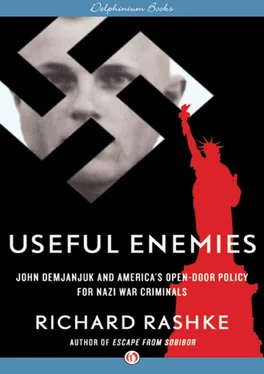With that distinction in mind and with the full support of both Nuremberg and the High Commission, the DPC ruled: “The Baltic Waffen-SS units (Baltic Legions) are to be considered as separate and distinct in purpose, ideology, activities, and qualifications for membership from the German SS, and therefore the Commission holds them not to be a movement hostile to the Government of the United States.”
The decision was as complex as it was controversial.
It is clear that the Baltic Legions did not collaborate with the Nazis in rounding up, robbing, and killing Jews and Gypsies for a simple reason—by 1944 there were few if any left to kill. At the same time, no one could possibly deny that there were war criminals guilty of genocide among the ninety thousand Baltic Legion soldiers. But how many? Hundreds? Thousands? No one knew in 1950, when the DPC ruled, and estimates today would be mere guesses.
It was also true that the vast majority of the Baltic Legion conscripts were not war criminals before being drafted. So why punish the innocent majority because of the crimes of the minority? Implicit in the DPC ruling was a decision to separate war crimes from forced membership in a Baltic Legion.
In sum, if it could be shown that a member of a Baltic Legion had committed war crimes as a member of an organization inimical to the United States before being conscripted into a Baltic Legion, he would be denied a U.S. visa. Otherwise, he would be welcomed to America as a valued, anticommunist freedom fighter.
American émigrés and their national and international organizations, such as Latvian Relief, Inc., were basically pleased with the DPC ruling. So was the U.S. Catholic Church because the majority of Latvians living in the eastern part of the country were Catholic. Jews, on the other hand, considered the ruling anti-Semitic. DPC commissioner Harry N. Rosenfield gave voice to the fierce objection of his fellow Jews in his dissenting vote (there were two votes in favor).
The argument of the Jewish community against the ruling was logical, to a point. Although most members of the Estonian 20th SS Division (30,000) and the Latvian Legion (60,000) were forcibly drafted into the Waffen SS, their ranks were populated with police and militia volunteers who had collaborated with the Nazis to round up, rob, and murder Jews, Gypsies, communists, and Soviet POWs before the January 1944 general conscription order. (Latvians argue that the conscription began in mid-1943.) Also in the ranks of the Baltic Legions were men who had voluntarily joined the Waffen SS—defined as a criminal organization by Nuremberg and as inimical by the DPC—before conscription began.
By exempting former members of the Baltic Legions, the Jewish community argued, the DPC unfairly opened America’s door for the war criminals in their ranks. Hadn’t the DPC blocked all former members of the Waffen SS in other European countries from entering the United States, knowing full well that not every Waffen SS member had volunteered, or, if he did volunteer, had actually committed a war crime? Why should Estonia and Latvia get special treatment?
A brief review of the scope and brutality of Estonian and Latvian collaboration with the Nazis helps explain the angry reaction of the Jewish community to the problematic Baltic Legion decision and the impact the ruling had on U.S. immigration policy.
In the end, the argument of the Jewish community turned out to be legally correct. Thirty years after the Baltic Legions decision, the U.S. Supreme Court ruled that involuntary induction into a criminal Nazi organization was not an extenuating circumstance to be considered in granting a visa to the United States.
• • •
The German army entered Estonia and Latvia in July 1942, a few weeks after it invaded the Soviet Union. By July 1943—long before conscription into the Baltic Legions began—nearly 100 percent of Estonian Jews, 80 percent of Latvian Jews, and 80 percent of Estonian and Latvian Gypsies had been executed and their property stolen.
In the last fifteen years, historical researchers and research institutes in the Baltic countries and in the West have confirmed in some detail what was already known in 1950 when the DPC ruled that the Baltic Legions were not criminal organizations: 1) Estonian and Latvian militia and police collaborated with the Nazis in the execution of their Jewish and Gypsy populations; 2) without their assistance, making those countries virtually Judenfrei would not have been possible; 3) the motives for this indigenous collaboration were varied; and 4) Estonia and Latvia are still struggling to understand and accept responsibility for their part in the genocides.
Estonia was unique among nations. With a population well under two million, it was the smallest nation in the east, with the smallest number of Jews (one thousand). It had a history of peaceful coexistence and cooperation with the Jews who lived in the major Estonian cities of Tartu and Tallinn.
Estonia also had the highest World War II death rate of any country—an estimated 25 percent of its total population. And it was the first country the Nazis declared Judenfrei. With the help of Estonian volunteers, the Nazis managed to wipe out the entire Jewish population in one year.
Those numbers, however, do not tell the whole story.
Before the Nazis finished building the death camps of Belzec, Sobibor, and Treblinka in eastern Poland, they transported to Estonia for execution an estimated ten thousand Jews, mostly Germans and Czechoslovakians. At the same time, the Nazis built a string of work camps in Estonia to house another estimated twenty thousand Jewish slave laborers from the west to work in the country’s strategically important shale-oil mines.
The Nazis relied on volunteers from the Estonian Home Guard (Omakaitse) and Security Police to serve as guards to round up the country’s Jews and Gypsies, and then to execute them along with the foreign Jews sent to Estonia to die. Most victims were taken to trenches in the woods and shot by six- or eight-man teams of German soldiers, SS officers, and Estonian volunteers.
Based on the testimony of eyewitnesses during the war crimes trials conducted in Estonia in the 1960s, the Nazi collaborators were brutal. They raped and forced women to work as sex slaves, then killed them when they were worn-out; they tossed babies in the air for target practice; and they buried wounded victims alive.
Just before the Soviets retook Estonia in 1944, the Nazis loaded onto ships the remaining Western European Jews who had been deported to work in the mines. The vessels brought them to Germany for reassignment at work camps. Those unable to work were executed. A few survived the war and were liberated by the Allies.
In neighboring Latvia, anti-Semites didn’t bother to wait for the Germans to arrive. After the Soviets withdrew, they began hunting and executing Jews with enthusiasm. Once the Germans arrived in July 1941, these anti-Semitic Latvians helped them “incite other Latvians to a Jewish action without much prodding,” according to American historian Valdis O. Lumans. In less than two years, the Nazis and their Latvian collaborators—mostly volunteers from self-defense and police units—murdered 90 percent of Latvia’s 95,000 Jews.
According to Lumans, two of the most rabid Latvian Nazi collaborators were Voldemars Veiss, a lieutenant colonel in the Latvian national army, and Viktors Arajs, a Latvian policeman. Veiss, who was probably an ethnic German ( Volksdeutsche ), organized an initial auxiliary police unit of about four hundred Latvian volunteers to find and execute communists and Jews. Arajs organized a similar unit of two to three hundred thugs known as “Arajs’ Boys.” Both leaders took out newspaper ads seeking volunteers “to participate in the cleansing of our country of destructive elements.”
Читать дальше












